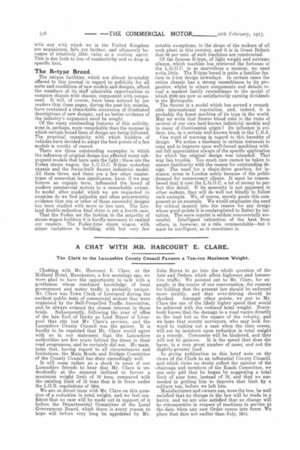The B-type Breed.
Page 2

If you've noticed an error in this article please click here to report it so we can fix it.
The unique facilities, which are almost invariably offered to this journal in regard to publicity for all sorts and conditions of new models and designs, afford the members of its staff admirable opportunities to compare chassis with chassis, component with component. It will, of course, have been noticed by our readers that these pages, during the past few months, have contained a remarkable succession of illustrated descriptions of new designs, and no better evidence of the industry's expansion need be sought. Of the many outstanding features of this activity, none is, perhaps, more remarkable than the manner in which certain broad lines of design are being followed. The practical unanimity with which builders of vehicles have decided to adopt the best points of a few models is worthy of record.
There are three outstanding examples in which the influence of original design has affected many subsequent models that have seen the light; • these are the Foden steam wagon, the L.C.O.C. B-type motorbus chassis and the Swiss-built Saurer industrial model. All these three, and there are a few other mastertypes of somewhat less significance, have, if we may borrow an organic term, influenced the breed of modern commercial motors to a remarkable extent, In model after model which we are requested to examine do we find palpable and often praiseworthy evidence that one or other of these successful designs has been studied with more or less care. The Leyland double-reduction final drive is yet a fourth case. That the Foden set the fashion to the majority of steam-wagon builders it is hardly necessary to remind our readers. The Foden-type steam wagon, with minor variations is building, with but very few
notable exceptions, in the shops of the makers of all such plant in this country, and it is in Great Britain that 95 per cent. of such machines are constructed.
Of the famous B-type, of light weight and extreme silence, which machine has retrieved the fortunes of the L.O.O.C. in so marvellous a manner, we need write little. The B-type.breed is quite a familiar feature in 3-ton design nowadays. In certain cases the entire chassis has a strong resemblance to its progenitor, whilst in others components and details reveal a marked family resemblance to the model of which 2500 are now so satisfactorily earning dividends in the Metropolis.
The Saurer is a model which has earned a remarkable international reputation, and, indeed, it is probably the finest machine of its type in the world. May we write that Saurer blood runs in the veins of several of our own best-known industrial models and in many of .Continental origin Its influence is evident, too, in a certain well-known truck in the U.S.A. One word of warning in regard to this heredity of design. We notice a tendency in certain instances to copy and to improve upon well-famed machines without full appreciation always of the specific application for which the original design was intended. That way lies trouble. Too much care cannot be taken to ensure familiarity with the reason for outstanding design. The need for a chain-drive gearbox, for instance, arose in London solely because of the public demand for unnecessary silence. It must be remembered that it cost the L.G.O.C. a lot of money to perfect this detail. If its necessity is not apparent to other makers, they will do well not blindly to follow such example. We, of course, merely quote this component as an example. We would emphasize the need for critical inquiry into the reason for any design whose good points it is contemplated to flatter by imitation. The mere copyist is seldom commercially successful. Intelligent extraction of the best from others, is, however, as a rule, commendable—but it must be intelligent, as it sometimes is
































